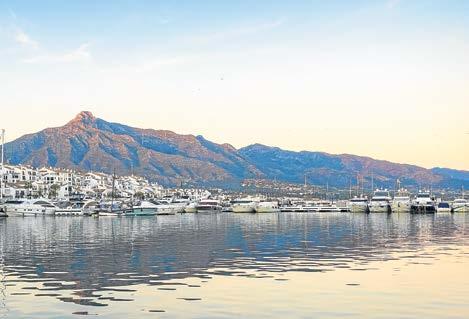
2 minute read
An all-year-round resort
pleasure.
A town of over 150,000 year-round residents, it is almost uniquely a resort that never hibernates. Indeed, as most locals will nowadays tell you, the best months are from October to May, when the tourist numbers remain manageable, while all the top restaurants are still open and the sports clubs buzzing. Meanwhile, infrastructure-wise it counts on dozens of excellent private schools, two cinemas showing VO movies and just about every shop you could desire for from Corte Ingles to the Apple store and Gucci to Specsavers.
Since the 1950s, Marbella has been the glamorous dream escape for movie stars, sportsmen and captains of industry. Photos of the glamorous destination fill glossy travel magazines around the world and it’s probably the most aspirational place to live in Europe, bar perhaps San Tropez, Mallorca or Ibiza.
An exclusive resort, it has long attracted celebrity visitors such Audrey Hepburn, Cary Grant and Sean Connery, while hundreds of sportsmen like Novak Djokovic and Eden Hazard own houses here, and you’ll frequently find boxers, including Tyson Fury and Anthony Joshua, in the gyms, or Harry Kane and Gareth Bale on the fairways. The pandemic has only made things more pronounced, creating the opportunity for tens of thousands of digital nomads and entrepreneurs to decamp down here from northern Europe and further afield.

With the likes of Dragons Den’s Theo Paphitis and tycoon Alan Sugar already owning here and crooner Julio Iglesias with a giant estate in the hills, don’t expect any villas these days to be going for a song.
Since the resort’s five-star hotels were filled to bursting during the two years of Covid, dot.com millionaires can snap them up at asking price before siesta time. Prices have continued to soar this year to incredible heights and Marbella was one of the first places in Spain to return back to the levels of 2006 before the crisis kicked in. Prices have nearly doubled in a decade and asking prices rose by 20% last year alone, while at €4,121 per metre squared it is the among the most expensive property in Spain. There are simply not enough properties for sale, plots to build are far and few between and listings are becoming incredibly scarce to come by. Demand far outstrips supply.

“Marbella is almost bulletproof from a slowdown or crash,” explained estate agent Adam Neale, of Terra Meridiana. “It is almost unique in Europe.” But what is certainly different about Marbella than other nearby resorts like Estepona or Mijas (or further afield in Javea or Ibiza, say) is its amount of history and culture on offer, when you know where to find it.
And let’s not forget to mention the superb walks in its nearby hills - it sits next to a National Park, these days, don’t you know - while it easily has the best concentration of restaurants in southern Spain.
History-wise there is certainly a fair amount to do from inspecting its Moorish walls in the casco historico, to visiting a Roman villa or Visigothic church on its outskirts.
Indeed, rewind the clock sev- eral millennia, and you’ll find it’s always been a popular spot.
Marbella’s earliest origins are as a palaeolithic settlement. Humans hunted and gathered over the very same land that now boasts Michelin-starred restaurants.

The Phoenicians were here, before Its next incarnation came as a Roman port. You can see the evidence at the
Continues on page 4






